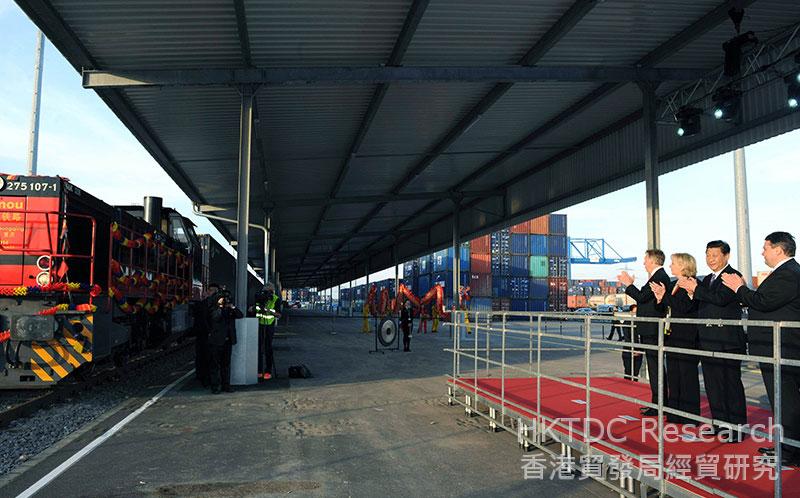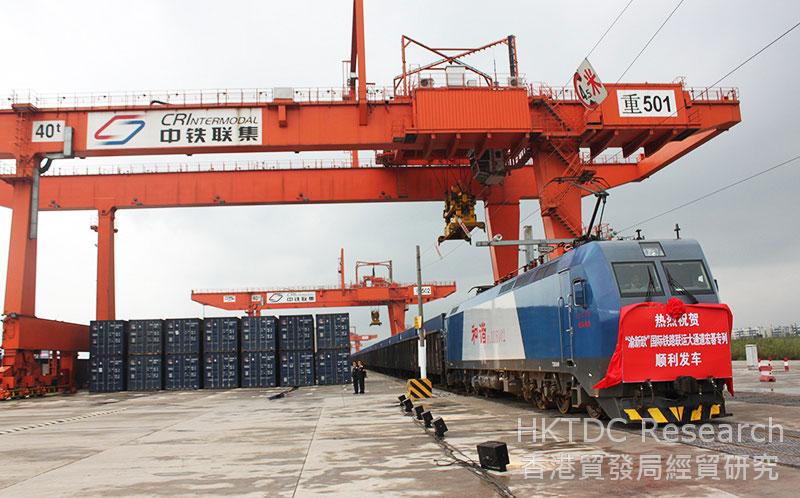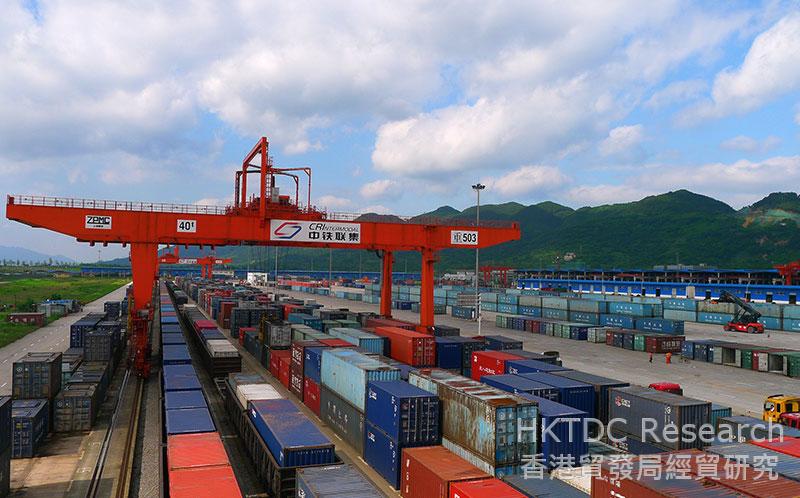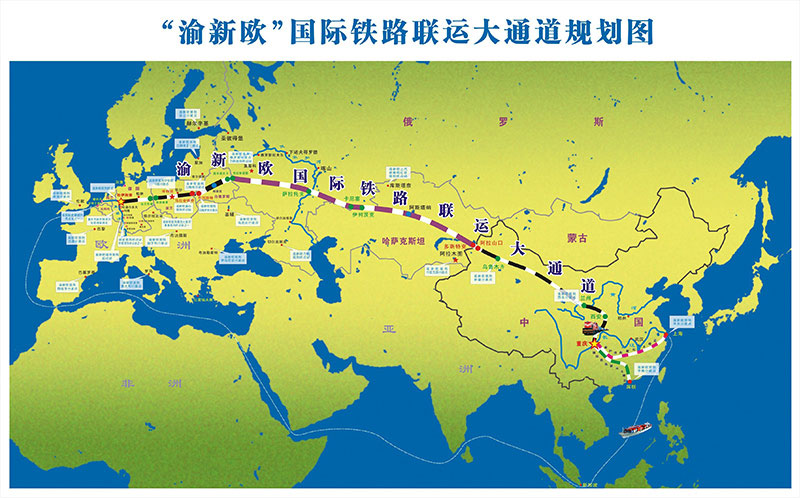China-Europe Express Trains: On Track to Access Belt and Road Businesses
China-Europe Express Trains: On Track to Access Belt and Road Businesses
Since the launch of the China-Europe Railway Express (CR Express) linking China with Europe by fast-track cargo rail, freight volume has increased substantially, particularly in the past year. The CR Express is of increasing interest to companies wanting to transport Chinese products to Europe while tapping markets along the Belt and Road routes, including manufacturers in western China and companies in the coastal region looking for an alternative to sea freight. Some companies even take advantage of these freight trains’ speed and customs clearance facilitation to bring imports into the booming domestic market.
As the CR Express service is expected to continue to improve, Hong Kong manufacturers and traders could consider using rail as an adjunct to sea transport in order to develop inland market opportunities along the Belt and Road routes in both Asia and Europe. Logistics providers could also strengthen co-operation with railway logistics companies to connect with logistics networks in Hong Kong, so as to further strengthen their niche in international transport and logistics in sea and air transport.
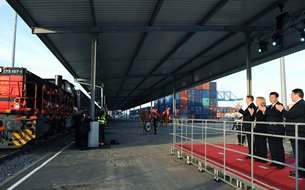
(Photograph provided by Yuxinou (Chongqing) Logistics Co Ltd.)
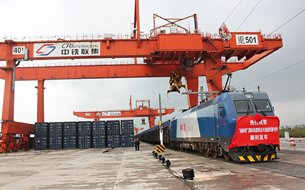
(Photograph provided by Yuxinou (Chongqing) Logistics Co Ltd.)
Fast Expansion of Services to Cover the Whole Country
China’s Europe-bound freight-train service (now formally named the CR Express) was launched in March 2011, with the first train setting off from Chongqing to Duisburg, Germany. As of August 2016, more than 2,100 trains[1] had been dispatched via the Yuxinou (Chongqing-Xinjiang-Europe) International Railway. Currently, the CR Express provides regular rail services to at least 16 Chinese cities, including Chongqing, Chengdu, Zhengzhou, Wuhan and Suzhou, calling at more than 12 cities in eight European countries[2]. Of particular interest is the fact that CR Express services have grown rapidly in the past year, with increasing numbers of mainland companies relying on rail to transport goods to Europe.

The CR Express provides not only direct railway transport to Europe from China, but also a one-stop service in cargo inspection, quarantine and customs clearance thanks to the support of relevant government authorities. Notably, the technical specifications of the railway system and rail tracks are different between China, countries in Central Asia and Europe. Trains need to change from one rail track system to the others when crossing the China-Russia border, entering Central Asia (countries such as Kazakhstan), and arriving in Eastern Europe and Western Europe. However, such technical issues have been resolved thanks to the concerted efforts of the railway and shipping companies concerned. Today, most logistics operators are capable of monitoring the cargo during the whole process and provide the consignor with clearance on arrival at the railway terminus, warehousing and transshipment to the desired destination.
|
Yuxinou International Through Railway Transport Chongqing launched the first Europe-bound freight-train through railway service, via the Yuxinou (Chongqing-Xinjiang-Europe) International Railway, in March 2011, departing from Chongqing, passing through Alashankou in Xinjiang, crossing Kazakhstan, Russia, Belarus, Poland, and finally reaching Duisburg in Germany. Covering a distance of about 11,179km and taking about 14 days, the Yuxinou Railway now offers a weekly scheduled train service. Transportation via the Yuxinou Railway saves about 20 days compared with rail/sea intermodal transport (via Chongqing-Shenzhen Railway and then by sea to Europe) or river/sea transport (via the Yangtze River to Shanghai and then by sea to Europe). According to China Customs statistics, about 85% of the total value of goods handled by the CR Express via Alashankou in Xinjiang is carried by the Yuxinou Railway. Boosted by local and foreign investment inflow, the technology industry in Chongqing and its neighbour Chengdu provides the main exports carried by the Yuxinou Railway, with goods including notebook computers, printers, LCD monitors and other IT products. Among them are brands such as HP, Acer, Asus and Toshiba. The Yuxinou Railway also carries imported goods, including auto parts and finished vehicles. The majority of the cargo is high value-added items, and requires urgent delivery. In an interview with HKTDC Research, a representative of Yuxinou (Chongqing) Logistics Co Ltd said that currently about 40% of goods carried on Yuxinou trains were exports from local enterprises in Chongqing, 30% were from East China, and another 30% were from South and Southwest China. He noted that companies could now take advantage of the Yuxinou Railway's logistics and transportation services to deliver goods to Germany, Poland, the Czech Republic, Moscow and Cherkessia in Russia, Astana and Almaty in Kazakhstan, and then transship them to other destinations. The further expansion of related logistics services presents them with Belt and Road business opportunities in Central Asia and Eastern Europe, as well as in export markets in Western Europe. |
Currently, the CR Express mainly passes through Alashankou/Korgas in western China to Kazakhstan, Erenhot in northern China to Mongolia, and Manzhouli/Suifenhe in northeast China to Russia. Major lines in service include:
- Chongqing to Duisburg, Germany: about 11,179km; about 14 days.
- Chengdu to Łódź, Poland: about 9,826km; about 10 days.
- Zhengzhou to Hamburg, Germany: about 10,399km; about 17 days.
- Suzhou to Warsaw, Poland: about 11,200km; about 12 days.
- Wuhan to Lyon, France: about 11,300km; about 15 days.
- Changsha to Duisburg, Germany: about 11,808km; about 18 days.
- Yiwu to Madrid, Spain: about 13,052km; about 21 days.
Note: Train services are expected to continue to improve. For updates, please make enquiries with the relevant railway departments.
Source: China Railway Corporation; Chengdu Investment Promotion Commission; Yuxinou (Chongqing) Logistics Co Ltd; Henan People’s Government; Jiangsu Department of Transportation
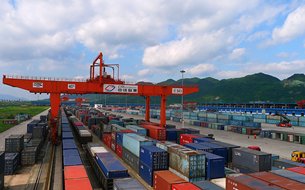
(Photograph provided by Yuxinou (Chongqing) Logistics Co Ltd.)
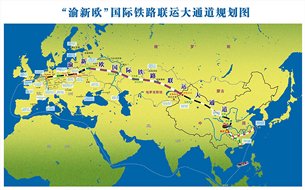
(Photograph provided by Yuxinou (Chongqing) Logistics Co Ltd.)
Supplementing Air and Sea Freight
By helping companies to export goods to Eastern Europe and Western Europe, the CR Express is playing an important role in China’s Belt and Road strategy and helping to strengthen bilateral trade and investment with countries along the route. Furthermore, some logistics operators also provide clients with transit services from the terminuses in Germany and Poland to neighbouring areas, effectively extending the coverage of the CR Express.
Of particular interest is that the CR Express was earlier used primarily for transporting Chinese exports to Europe. But Chinese companies are now increasingly using the service to import goods from Europe. In the first half of 2016, the CR Express operated 619 train services (a 150% increase year-on-year), of which 410 departed from China, and 209 returned (a 318% rise year-on-year[3]), representing 51% of the number of departures.
IT and other electronic products are now the major categories of export goods currently carried by the CR Express. Others include household appliances, machinery and equipment, auto parts, food, clothing, general goods, and e-commerce merchandise. Interestingly, although many e-commerce items are mainly transported by air, they are being carried increasingly via the CR Express. On the other hand, imports mainly include wood products, food, agricultural goods, auto parts and finished vehicles.
Generally, these China-Europe freight trains transport cargo to their destinations three times faster than shipping by sea for one-fifth of the cost of transport by air[4]. While rail freight is still more costly than sea freight, the CR Express can work as an adjunct to sea and air transport, and rail connections are likely to increase as more and more companies use rail services to expand China-Europe trade.
Europe-bound services from the Guangdong province have also been launched, such as the service from Guangzhou to Vorsino in Kaluga, Russia via Manzhouli in Inner Mongolia, which began in August 2016. This was the second Europe-bound train service from the province, following the service from Shilong, Dongguan to Duisburg, Germany, which started operating in April 2016. According to China Railway Corporation’s information, the line covers a distance of 11,500km, taking about 15 days. Clothing, footwear, computer accessories and electronic equipment produced in the Pearl River Delta (PRD) region were shipped using a standard 40-foot container. The railway company is planning to strengthen Europe-bound train services from Guangdong, and is actively working on rail connections with Kazakhstan and Uzbekistan in a bid to transport more goods manufactured in the PRD region and southern China to markets in Central Asia and Europe.
Implications for Hong Kong Companies
The recent rapid expansion and increasing frequency of Europe-bound rail services, and the significantly shorter lead time of 10-12 days for the fastest routes, means rail has gradually become a viable alternative to sea and air transport for export and import enterprises exploring European trade opportunities. Meanwhile, the related railway transport companies are actively working with countries along the CR Express route to negotiate not only transit arrangements, but also the feasibility of stopovers to collect cargoes halfway on the route. This is to align with the current China-Asia CR Express service, whose freight trains are departing from China and heading to Asian countries like Nepal, Kazakhstan and Uzbekistan.
These developments will effectively enhance the transport links between China and countries in Asia and Europe and strengthen the capabilities of related logistics providers of cargo transportation and distribution. Under such circumstances, Hong Kong companies may need to consider the feasibility of the further use of rail transport to enhance their flexibility in expanding into Eurasian markets. Furthermore, logistics operators can also strengthen partnerships and co-operation with the relevant railways, helping to connect them to logistics and transport networks in Hong Kong, and so enhance their advantage in the international transportation and logistics business.
[1] Source: Information released by China Railway Corporation on 30 August 2016.
[2] Source: Information released by China Railway Corporation on 18 July 2016.
[3] Source: China Railway Corp
[4] Source: National Development and Reform Commission
| Content provided by |

|
